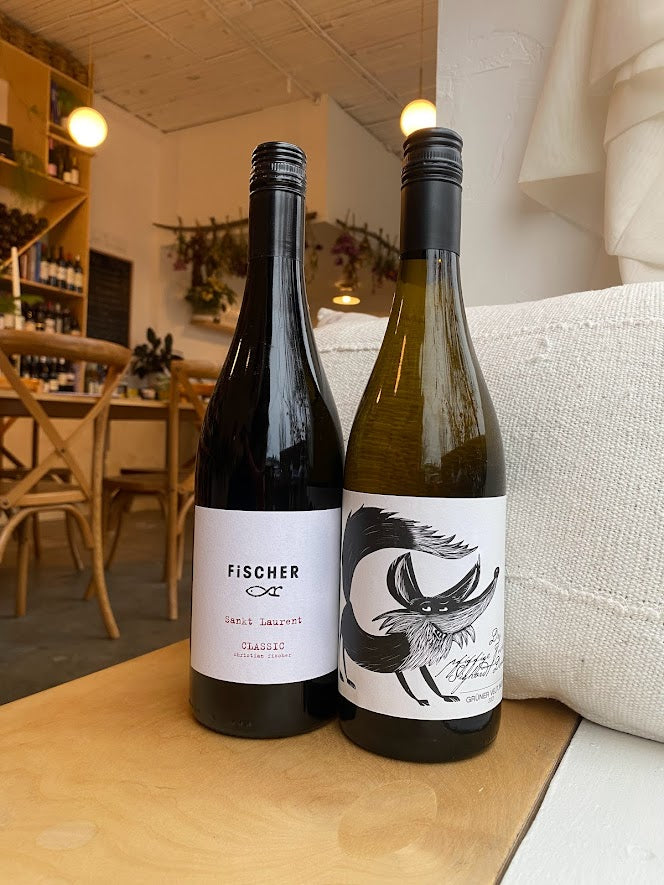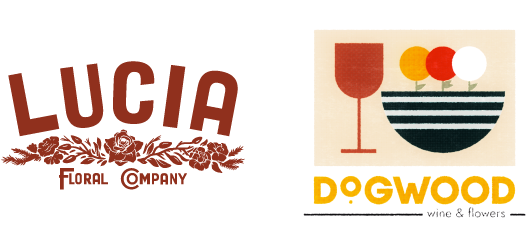
October 2023 - Austria
October 2023
Austria
Featuring:
Sighardt Donabaum
Christian Fischer
The first, and only time so far, that we focused on Austria was August 2022. We covered the 4000+ year winemaking history in the area, the Antifreeze scandal in the 1980’s, and elaborated on a few of the most popular wine regions & grapes grown in the country. If you weren’t a member then, you can find that information here. This month, we’ll do a deeper dive into the two regions we are featuring - the illustrious Wachau and the little-known Thermenregion - both a part of the larger Niederösterreich (Lower Austria).
Wachau
Wachau (pronounced Vu-k-ow) is unequivocally the region home to the highest concentration of top Austrian winemakers. Names include Nikolaihof, Knoll, Alzinger, Pichler, Prager, and more. The river valley is located on the Danube upstream (West) of Vienna, nestled between the south end of the Bohemian Forest and the east end of the Bavarian Alps. The area has well earned its UNESCO world heritage site distinction with its terraced vineyards, quaint preserved old towns, and medieval historical sights.
Climatically speaking, the region is cold with a continental climate and a latitude similar to that of Victoria, BC. The elevation of vineyards ranges from ~600ft (river level) to ~1500ft, which can speak to the steepness and necessity of terracing in the vineyard (~⅓ are terraced). The wide, slow Danube river offers some respite, however, moderating hot temperatures in the summer and cool temps in the winter. The best vineyards have a southern exposure, grown in steep terraces on the river’s north bank. The full south-exposure paired with the reflection of the sun off the river allows for more consistent ripening in an unpredictable climate. Another heat-sink is the stone terraces. Made up of gneiss and marble, these dry (mortar-less) terraces absorb heat during the day and release it at night.
The Wachau produces roughly 95% white wine - almost entirely dry Riesling and Grüner Veltliner, the hallmark grape of Austria. It is home to some of the best expressions of each grape the world over. While the region lacks specific Grand Cru style designations like France’s Burgundy has, there are numerous top vineyards that different wineries have access to. Ownership is not as fractured as Western Germany or Burgundy - largely due to the absence of Napoleonic law - but also not as centralized as Bordeaux.
In similar fashion to Germany’s outgoing pradikat system, Austria has its own ripeness designation system. Here, wines can be classified as Steinfeder, Federspiel and Smaragd. These registered trademarks can only be used in certain regions and require a set of parameters. The lightest, Steinfelder, is less often exported and designated a wine as light, crisp, and easy drinking; a nod to the native grass (Steinfedergras) that grows in the Wachau. The second, Federspiel, is what we’re most likely to encounter. These wines are stronger, with richness and character but still a brightness and acid-driven fierceness to them. They are an homage to the art and hobby of falconry in the region. Lastly, Smaragd designated wines are the fullest, richest and most powerful of the bunch. These are often only from top vineyards and will usually have some percentage of noble rot in the grapes. These are the longest lived, most complex of Austrian wines. Smaragd is named after the local green lizards that sun themselves on the terrace rocks.
Thermenregion
While Wachau may be the king or queen of Austrian wine, Thermenregion likely wouldn’t even be in the royal family. That’s not to say anything about quality, but rather popularity. In my decade plus in this industry, the red from Christian Fischer we are featuring this month was my first from this appellation. Though I must say, I’m now on the hunt for more!
Thermenregion extends from Vienna’s southern border, through the Vienna basin, and into the eastern edge of the Limestone Alps. It is what some Europeans call a ‘spa region’ - the geo-thermal forces have lead to a millenia long tradition of spas and bathhouses, which have become the central point of many towns. Baden bei Wein is an example of this. Similar to Germany’s Baden Baden (‘baden’ means ‘bath’), the town is home to numerous baths, public and private, and remains a popular tourist attraction for that reason. In the wine trade, however, some Austrians refer to this area as ‘Austria’s Burgundy’ due to the similar climatic conditions, prevalence of limestone, and high quality of red wines coming out of this area.
In Thermenregion, rather than Grüner or Riesling, primarily red grapes and a couple of unique indigenous varieties are the primary focus. Zierflander, also called Spätrot, is the most popular. It’s believed to be a cross between Traminer and Roter Veltliner. The grapes have a pinkish hue, light floral notes, and are often blended with Rotgipfler, the other grape native to Thermenregion. Interestingly enough, Rotgipfler is a crossing of the same two grape varieties but has relatively different characteristics. The grapes are colored more white/yellow, and generally have higher acid and more aromatic notes than their cousin Zierflander. Other grapes grown in this region are Pinot Blanc, Chardonnay, Pinot Noir, and Saint Laurent. Thermenregion produces a decent amount of wine - production is on par with Wachau or Kremstal, which are 1/10 of the size. However, most bottles stay within the country to be consumed in or around Vienna. Of the wines that are exported, it’s more likely to see St. Laurent or 'Spätrot-Rotgipfler’ (a blend of the two grapes above).
Sighardt Donabaum, ‘Weingarten’ Grüner Veltliner, Wachau 2021
The Donabaum winery is located in Zornberg, just outside of Spitz in the Wachau. The winery has physical history dating back to the 12th century, but has been in the Donabaum family since 1833. Sighardt himself is in his mid-40’s, rocking short gray hair and a pony-tailed beard reminiscent of a viking or modern day metalheads. He was welcomed into the Association of Young Winemakers in Austria in 1997, which focuses on traditionally-styled wines, made using innovative techniques.
Today, the Donabaum winery farms 11 hectares (27 acres) of steep, demanding vineyards on the terraced hillsides of the Wachau. 80% of their vineyards are terraced and all of their holdings are farmed by hand due to the impassibility of machines on the terrain. Everything is fermented in stainless steel, with minimal intervention (native yeasts, low SO2, unfiltered) The estate only produces wines of the Federspiel and Smaragd ripeness levels, opting for quality over quantity.
This wine, the ‘Weingarten’ cuvee, is a blend of several different vineyard designates, made in the Federspiel style. It is dry, with a rich golden hue and savory pepper/mineral notes to compliment the starfruit, green apple, and lemon. Grüner is known for being one of the most versatile pairing wines, so you can be confident enjoying this with anything. Even some of the more ‘tricky’ pairings like asparagus or artichoke tend to go well with Grüner!

The terraced vineyards of Weingut Sighardt Donabaum, Wachau.
Christian Fischer, ‘Classic’ St. Laurent, Thermenregion 2018
If you thought the Donabaums’ 190-year history in the Wachau was impressive, well… the Fischer family has been farming and making wine in Thermenregion since 1662 -a cool three hundred and sixty one years. The family has been operating out of their ancestral home in the village of Sooß, located just outside of the town of Baden bei Wein.
Christian’s father, Engelbert Fischer, was the vintner and proprietor from the middle of the 20th century through the 80’s. After completing an intensive viticulture course, Christian took over in 1983 and has been the sole proprietor for 40 vintages now. He was one of the first Austrian winemakers to bring French barriques into the mix, experimenting in 1985 with a now-renowned Pinot Noir bottling. (Traditionally, Austrians have used large, foudres up to 3000L in size, rather than the small, 225L barrique we are all familiar with). Christian also advocated for completion of an adequately sized, modern winery next to the family’s home rather than using the ancestral cellar.
This St. Laurent comes from 35+ year old vines that are grown organically and tended by hand. After a gentle destemming and crushing, the wine undergoes primary and secondary fermentation in a steel tank. It is then given roughly 18 months to age in large foudres before bottling.
St. Laurent is believed to be a crossing of a native Austrian grape and Pinot Noir, however no one is sure exactly when or where it came from. It is commonly thought of as a beefier, more brooding Pinot and that is where I land with this wine. Dark red and black fruit on the nose, with a touch of earth and savory spice. It is similar in acid profile to your average Pinot, but shows denser, more persistent tannins and a fuller body. This is the perfect Fall red in my opinion - not too heavy, but not too light. Great with roasts, stews, and even pumpkin or squash!

The vineyards of Weingut Christian Fischer, Thermenregion.
